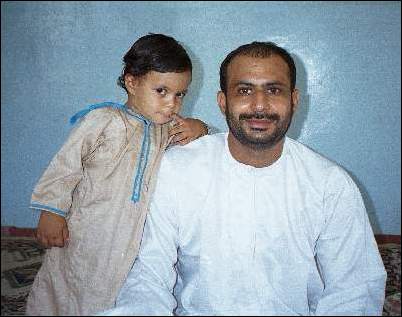
Mohammed's falaj This page is revised on the 24 May 1999.
Two months after I came to Oman I drove by coincidence into
a village from which there was no exit. While I tried to turn the car around a man came
running towards me. He asked me to come and visit him and his family and to have coffee
and dates with them. That was the first time I saw Mohammed.

Since then I have visited Mohammed many times and I almost feel like a family member.
The village is located in the picturesque Jabal Akhdar
massif. The name Jabal Akhdar means The green Mountain. It relatively often rains up there
and there are plenty of caves inside the mountains to keep the water for a long time. The
water is released slowly and supplies the surrounding villages with water.


It is Mohammed's village in the centre of the picture.
The village gets the water from a well below the village, and from a spring up on the side of the mountain. For the purpose of making the water flow more efficient from the spring to the village the villagers have build a canal or a falaj (pronounce with two short 'a'). This falaj is the life line of the village. The falaj delivers water for the fields, the datepalms and for the animals. The village is almost self-sufficient with meat, vegetables and fruit.




Simply build a bridge if the water has to cross the wadi
bottom.


The age of the falaj is not quite clear. But it is evident that
is has been there as long as people have lived in that area. The falaj is still being
extended further up in direction of the spring. This is to minimise loss of water to the
nature. On the picture above are two generations of the falaj visible. The top one, the
older one, is not in use any longer and was replaced by the lower, newer one. The older
one was given up because nobody was any longer able to maintain it, mainly because it is
positioned on a precipice. The new one is put in a place where most people are able to
access to.

The falaj is maintained by the group. On regular interval they go and clean and repair the falaj.
It is not allowed just to use the water. The access to the water and the amount of water someone can take is regulated in details. The principle is that all families in the village should have the same possibility to get their gardens and palmtrees to grow properly.
Above the fields is there a pool in which the amount of water can be measured (the amount which runs out of the pool into the falaj and down to the fields, in a certain timeframe). Beside the pool is there a pole which functions as a solar watch. The principle is that Mohammed has the water at his disposal while the shadow of the pole moves from this stone to that stone (below Mohammed is pointing at one of his stones). Because there are advantages and disadvantages for certain crops they change from week to week the time of the day, where they have the water at their disposal.

So with the help of the water they get food on the table and
they also get the most picturesque views with mountains, palmtrees and green fields.

After a good long day up and down along the falaj one can
get a bit hungry and then a good barbecue is the solution.


Below we are approaching the 'table'. Everyone is eating
directly from the big plate in the middle with their fingers and hands (no cutlery).

Outside the house Mohamed's old uncle is relaxing in the sun
(it was still winter, when this picture was taken) together with a friend, while a third
man is sleeping his afternoon snooze.

From Mohammed's village it is also possible to walk some
wondrous walks up the mountain on old trails. These trails was the link between all
villages until roads were build from mid 1970s and cars were introduced. Until then the
people only had their feet and donkeys for travelling between villages. The trails are
partly quite exposed:


Is should also be mentioned that bee-keeping is very popular
(because of the honey). Mohammed also keeps bees and they live as normal is in Oman, in
hollowed datepalm logs.
